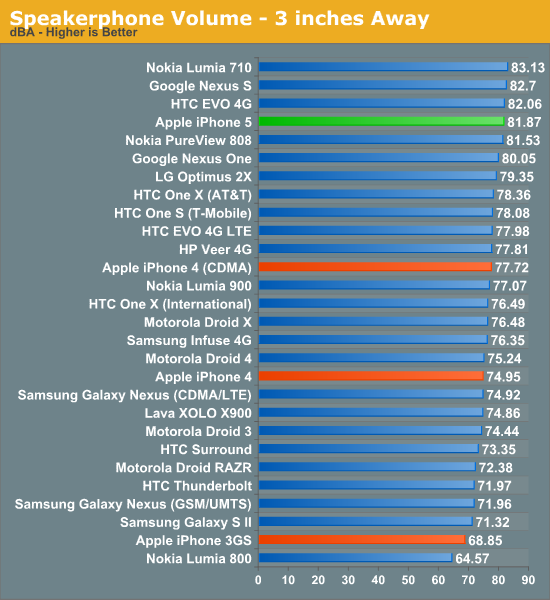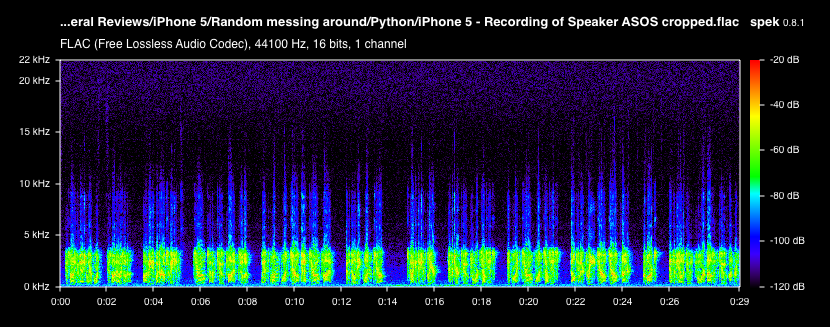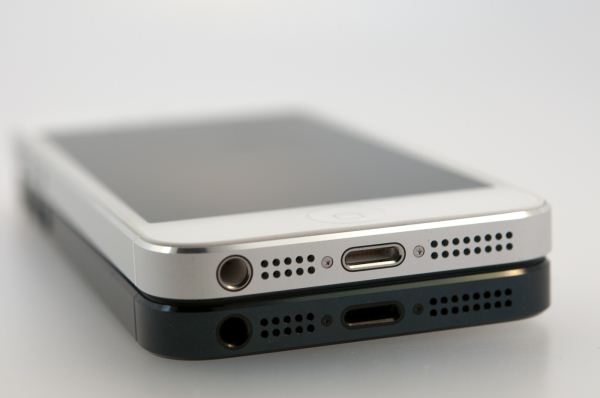The iPhone 5 Review
by Anand Lal Shimpi, Brian Klug & Vivek Gowri on October 16, 2012 11:33 AM EST- Posted in
- Smartphones
- Apple
- Mobile
- iPhone 5
Speakerphone and Noise Suppression
Section by Brian Klug
When Apple changed up the dock connector with the smaller Lightning port, it afforded a chance to also redesign the speakerphone at the bottom of the iPhone 5. Between the iPhone 4 and 4S we saw minimal changes, and performance was acceptable if a bit on the quiet side. With the iPhone 5 Apple advertised a big gain in audio quality with both changes to the speaker and a 5 magnet transducer design.
We normally test speakerphones by calling the local ASOS test number at max volume in front of an Extech sound data logger sampling continually and then averaging over one readout of the weather report. This gives a good feel for the overall loudness of the speakerphone on a call, but doesn’t tell us anything about quality unless you’re standing in front of it. In this case, the iPhone 5 is quite loud and comes in near the top of our scale at 81.8 dBA. It isn’t chart topping but a definite improvement over the relatively quiet 4/4S speakerphone design.

I decided to do something different though after getting a lot of questions and emails asking for a better quality comparison between the iPhone 5 speaker and its predecessor. People are interested in using their smartphones to listen to music when speakers or a dock aren’t available, and I thought this worth investigating. To get to the bottom of this I used my Blue Yeti USB microphone and arm which I use for podcasting to record the speakerphone output at 90 percent volume on the iPhone 4S and iPhone 5.
I started with the test call, which sounds surprisingly different between the iPhone 4S and iPhone 5. The 4S saturates and has obvious distortion even at 90 percent volume. This is quite noticeable in the recording. It then occurred to me that because I’m calling over AT&T (narrowband AMR) and to a PSTN (public switched telephone network) that the call would be limited to 4 kHz thanks to filters along the route, therefore anything above 4 kHz is undesirable. I took a spectral analysis (which shows power spectral density), and instantly it became obvious just how much energy there is on the 4S above the 4kHz limit from overmodulation or saturation/clipping on that speakerphone design. Meanwhile the iPhone 5 has much less energy over that 4 kHz maximum for a PSTN call.
I did the same for two songs recorded start to finish, and the differences are quite noticeable even in my rather quick and dirty recording plus spectogram comparison. I cropped the two recordings of the songs quite a bit and stuck them on soundcloud.

My overall impressions with the iPhone 5 speakerphone is that it has much less of a tendency to clip and saturate than the 4S, all while being noticeably louder. It’s still a smartphone speakerphone but to my ears the difference is pretty dramatic.
Noise Suppression
We’ve known for a while now that Apple changed up the slot for noise cancellation in the iPhone 5. The story goes something like this — Audience was a discrete chip on the iPhone 4, an IP block on the A5 SoC for iPhone 4S, and also an IP block onboard the A6 SoC for iPhone 5. The difference is that with iPhone 5 Audience isn’t enabled, and the company knows this because final characterization with both the final industrial design, microphones, and performance was never performed. Audience claims it met all of its deliverables and targets with the new IP block it built and gave Apple for inclusion on the A6. There’s obviously a lot of speculation about exactly why Apple chose to go with its own soultion versus Audience.
We’ve seen Audience earSmart noise suppression processors in a number of smartphones to date, and carriers often have their own specification for noise suppression to get certified. In addition, with wideband voice (AMR-WB in the case of the iPhone 5) noise suppression is even more important, to say nothing of how big of a topic this is with voice recognition based features like Siri. While we’re on the subject of AMR-WB, this feature is enabled on the iPhone 5 but I’m unable to test it on any of the carriers in the USA at the moment.
Anyhow, the iPhone 5 uses an Apple-specific solution with three total microphones all around the device. One primary microphone at the bottom of the device where you’d expect the primary microphone to reside, a secondary microphone between the LED flash and camera module, and a third right next to the earpiece for use with earpiece active noise cancelation. Apple’s solution is a beamformer (Apple said so in the keynote) and from what I can tell thus works entirely in the time domain. I’ve spent a lot of time playing around with the iPhone 5 trying to characterize its noise rejection, and the system appears to have a number of modes it will kick into after a 5–10 second adaptation time.
Earpiece noise rejection is something I talked about on the podcast right after the iPhone 5 hands on, and is one of those modes that the iPhone 5 will kick into if you’re in a loud environment. It isn’t active all the time, but when it does transition into working it provides a noticeable suppression of ambient noise and the same kind of pressure I’ve felt with other active noise canceling closed ear headphones. The improvement isn’t overwhelming, but it’s a sensation and feature I haven’t experienced on any other smartphones to date.
The rest of the noise suppression story is really one of testing. To test, I ran our normal test suite which consists of me ramping ambient music to 94 dBA while speaking into the device under test and recording the other side of the call. I’ve gotten ahold of the industry standard babble and distractor tracks used by carriers for testing noise suppression and will move to those in the future, for now though the test track I currently play is something I understand pretty well.
The comparison here is between the iPhone 4S and iPhone 5 to see just how ambient noise suppression has changed with this change in solution. The difference in technique is pretty apparent, and again indicates to me that the iPhone 5 is working in the time domain. You can see visible cut in and cut out on the waveform. The Audience solution has some hiss that develops at the absolute highest background noise volume on the 4S, but it also does an excellent job suppressing noise. The Apple solution doesn’t have this hiss, but passes both background noise and vocals from the music passed through the call at maximum volume. I hate to call this a regression, but the difference in technique means that there’s audible background noise that gets passed on while I’m talking on the iPhone 5. I think for normal callers the difference won’t be readily apparent, but with close inspection it is dramatic.













276 Comments
View All Comments
medi01 - Wednesday, October 17, 2012 - link
1) Compare ipad2's gamut, cough2) Check values on toms
http://media.bestofmicro.com/3/4/331888/original/g...
http://www.tomshardware.com/reviews/ipad-3-benchma...
Unlike anand, toms was beyond primitive contrast/brightness benchmarking for quite a while.
thunng8 - Thursday, October 18, 2012 - link
Not sure if I should trust Tom's figures compared to Anands's.In any case, both show the ipad3 has higher gamut, especially in sRGB.
steven75 - Wednesday, October 17, 2012 - link
I think what you meant to say is that AMOLEDs win on black levels and that's about it. LCDs still win in accuracy and most importantly ability to see them in outdoor settings.KoolAidMan1 - Tuesday, October 16, 2012 - link
Not even close. Even the better Android displays like the Galaxy S3 has a PenTile display. Despite having more "pixels" it actually has fewer subpixels than the iPhone does. Unless you have bad eyesight the S3 display looks really bad in comparison, and this is before we get to even worse smartphone displays out there by HTC, etc.Sufo - Tuesday, October 16, 2012 - link
Old pentile displays were visibly jaggy on vertical lines - even my old lumia 800 exhibited this to some extent. On the GS3 tho, it is not noticeable and it has nothing to do with eyesight.Your comment makes it sound (to someone who has seen many different smartphone displays in person) as though you haven't spent much time with the GS3 (read: many smartphones) at all. Simply mentioning that is uses pentile subpix config, from you, sounds like regurgitated information. Not only that, but you seem to gloss over the many benefits that amoled panels bring. It's arguable that these benefits are more important than an accurate colourspace on (specifically) a mobile phone - although it is ofc entirely subjective.
This brings me to the last tell of ignorance I noted; your mention of HTC. Have you used a One X? For those who do not like amoled panels, the display on the one x is perhaps nicer than both the gs3 and the ip5. Ofc you may say Android is not your cup of tea, and that's a perfectly justifiable stance, however it has nothing to do with display tech.
tl;dr You sound like you don't know what you're talking about
KoolAidMan1 - Tuesday, October 16, 2012 - link
I do know what I'm talking about given that I've seen many smartphones, and I've calibrated my share of desktop displays to sRGB.Differences in display tech aside, Android phones have never gotten color profiles right, EVER. They're almost always oversaturated, have too much contrast, and are inaccurate. Anand even posted a difference in color accuracy between several devices, and the profile for the S3 is totally what I expected.
The S3 really doesn't look good, period, but then again there are people who argue that TN panels are just fine against IPS. I'm used to hearing nonsense on forums when it comes to display from people who don't know what to look for.
KoolAidMan1 - Tuesday, October 16, 2012 - link
BTW, apologies if that came out harsh, but the difference in color and contrast accuracy between something like the S3 and a properly calibrated device is a night and day difference to me. I'm pretty sensitive to display quality though; my main desktop display at home is still an NEC and my plasma is a Pioneer Elite (RIP)rocketbuddha - Tuesday, October 16, 2012 - link
For Android you have the following 720p HD DisplaysSLCD - HTC Rezound (2011 tech)
SLCD 2 - HTC One X, Sony HD
HD SAMOLED Pentile - GS3, Galaxy Nexus, Moto Razr HD
HD SAMOLED RGB - Galaxy Note II
True IPS LCD - LG Optimus 4X, Optimus G
Super IPS LCD -Asus Padphone, Sharp phones etc
So you have big set of choices. If dark contrasts are important then SAMOLED is the way to go. SAMOLED RGB over SAMOLED Pentile.
If overall color and whites are important go with SLCD2.
IPS LCDs are the closest to the Retina Display and u have a choices there too. You can pick and choose what is good for you and have alternatives.
Spunjji - Thursday, October 18, 2012 - link
The HTC One X has what is hailed to be one of the best LCD smartphone displays out there. Your claim is invalid.Similarly, the Galaxy Note 2 has an AMOLED display without PenTile. Sure, it's lower density, but one does not hold a 5.5" screen so close to one's face.
medi01 - Wednesday, October 17, 2012 - link
""The iPhone 5 display is better than any current Android display.""Why don't you go hit your dumb head with something heavy, ipad would do?